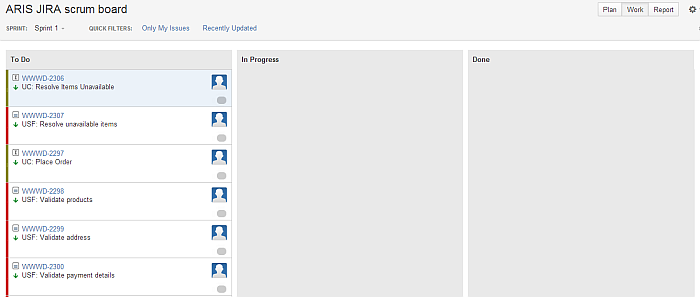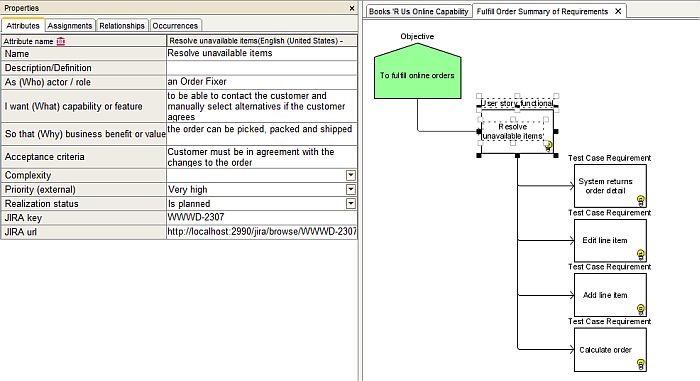Part 1: Requirements management overview
Part 2: Defining requirements using ARIS business designer
Part 3: Design using ARIS UML designer
Design using ARIS UML designer
In part 2, I described how one does a “mile wide, inch deep” view to define the product scope and to estimate the product scope using use case point calculations. Now before one starts with the design work, one needs to plan the design tasks. Here the initial requirements associated to the identified use cases can be exported from ARIS to JIRA in order to plan the product backlog.
Step 1: Export the requirements from ARIS to JIRA.
Step 2: Prioritize the requirements in JIRA using either a scrum / kanban board. In my example I will be using a scrum board to prioritize my product backlog.
Step 3: I can now plan my sprints and only include the use cases, user stories that I want to realize during the sprint
Step 4: Start sprint
Step 5: Track progress on sprint board. The items under the To Do list all relate back to the identified use cases & user stories identified in ARIS. The high priority use cases can now be designed into detailed use case specifications.
Step 6: Complete design artefacts for the high priority use case – Prepare Items Unavailable as in my example. From the use case I have assigned 4 models, each giving a different perspective of the use case.
Step 6a. Use case description indicating normal flow, alternative flows & exceptions
Step 6b. Use case flow using either BPMN process diagram or UML activity diagram (Optional), indicating normal (default path) flow, alternative flow and exception flow.
Step 6c. The associated UML class model for the use case (s)
Step 6d. UI design if the use case is a consumer or long run use case (Human actor involvement) and associate data elements to UI elements and define screen actions
Step 6e. Verifying the use case scenarios and associated classes using a UML sequence diagram
Step 6f. Associating test cases to defined user stories
Step 7: Generate the detail use case specification directly from the ARIS repository using a custom script called EasyReport
To summarize, during the scope phase the initial key requirements are defined which relates to the software scope. In parallel the initial solution architecture is designed to identify options on how the requirements can be realized. Use case point calculations can then be used to estimate the effort of the project based on the sea level use cases identified. From here requirements are exported to JIRA to plan the use case realization during define / design phases. Once the use case specifications (s) are complete, requirements are again exported to JIRA to update the JIRA issues with any additional requirements and test cases. Development can now commence.



.png)

.png)

.png)
.png)
.png)




.png)
Yubhesh Chaudhari on
Hi Etienne,
Thanks a lot for sharing detailed view. but I have below queries:
a) How you created UI in ARIS? Have you used Screen Design model to model UI? Or its only image of proposed UI?
b) If its UI image, then how you have connected “Enter search criteria” function object with this UI graphics? How you have created connection between “computer & technology” category and “category name” data element (ERM D attribute object)?
3. Which model type you have used to create “BCLC/SDLC” main model covering Requirement Management cycle?
//Yubhesh